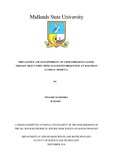Please use this identifier to cite or link to this item:
https://cris.library.msu.ac.zw//handle/11408/3703| Title: | Prevalence and susceptibility of uropathogens causing urinary tract infections in patients presenting at Masvingo general hospital | Authors: | Marimira, Tinashe | Keywords: | Urinary tract infections Diseases |
Issue Date: | 2018 | Publisher: | Midlands State University | Abstract: | Urinary Tract Infections (UTIs) are a serious problem globally and are some of the most common diseases encountered in medical practice today. Despite the widespread availability of antibiotics, UTIs remain a problem because of antimicrobial resistance. Antimicrobial susceptibility testing therefore provides information that allows physicians to select the most appropriate antibiotics for UTIs. This study was carried out to: (i) determine the prevalence of UTIs among patients presenting at Masvingo General Hospital, (ii) evaluate the sensitivity patterns of the identified isolates, and (iii) determine the efficacy of eight commonly used antibiotics (Ampicilin, Tetracycline, Nitrofurantion, Nalidixic acid, Gentamicin, Ciprofloxacin, Kanamycin and Norfloxacin) against the isolates using Kirby Bauer disc diffusion technique. A total of 123 urine samples were collected from patients seeking treatment for UTIs Masvingo General Hospital. Sample processing and patient information collection were carried out at Genau Pathology Laboratories in Masvingo. Urine samples were analysed following standard microbiological techniques. The bacterial isolates recovered were Escherichia coli, Klebsiella spp, Pseudomonas aureginosa and Staphylococcus aureus. Of the 123 samples examined, 47 (38%) comprising of 36(77%) females and 11(23%) males were positive for UTIs. The most common uropathogen was Escherichia coli with a prevalence of 47%, followed by Staphylococcus aureus (21%), Klebsiella spp (17%) and Pseudomonas aureginosa (13%). Antimicrobial susceptibility tests showed that the most effective antibiotic was nitrofurantoin being effective against 79% of the isolates, followed by gentamycin (66%) and kanamycin (66%). The least effective antibiotic was ampicillin, which was effective against only 4 out of 47 (9%) isolates, followed by nalidixic acid, effective against 19 out of 47 (40%) of the isolates. Escherichia coli was highly resistant to ampicillin but highly sensitive to nitrofurantoin. Klebsiella species were highly resistant to Ampicillin but highly sensitive to Kanamycin. Pseudomonas aureginosa was totally resistant to ampicillin but four drugs were effective against it, namely, nitrofurantoin, tetracyclin, ciprofloxacin and norfloxacin. Lastly, Staphylococcus aureus was resistant to nalidixic acid and ampicillin but highly sensitive to nitrofurantoin. Overall, the results suggest that the most common uropathogen causing UTIs in patients presenting at Masvingo General Hospital was Escherichia coli and most isolates were resistant to ampicillin and nalidixic acid but highly sensitive to nitrofurantoin, gentamycin and kanamycin. Therefore nitrofurantoin, gentamycin and kanamycin are recommended for treatment against UTIs. The relatively high prevalence (38%) of UTIs at Masvingo General Hospital suggests that UTIs are a risk to people around Masvingo Province thus there is need to monitor the profile of etiological bacteria of UTIs and the antimicrobial resistance regularly. This would show emergence of resistance to newer therapeutic agents as well as keep track of effectiveness of serving therapeutic agents. | URI: | http://hdl.handle.net/11408/3703 |
| Appears in Collections: | Bachelor Of Science In Applied Biosciences And Biotechnology Honours Degree |
Files in This Item:
| File | Description | Size | Format | |
|---|---|---|---|---|
| Tinashe_ URINARY TRACT INFECTIONS_Final.pdf | Full Text | 1.27 MB | Adobe PDF |  View/Open |
Page view(s)
100
checked on Jan 15, 2025
Download(s)
58
checked on Jan 15, 2025
Google ScholarTM
Check
Items in MSUIR are protected by copyright, with all rights reserved, unless otherwise indicated.


